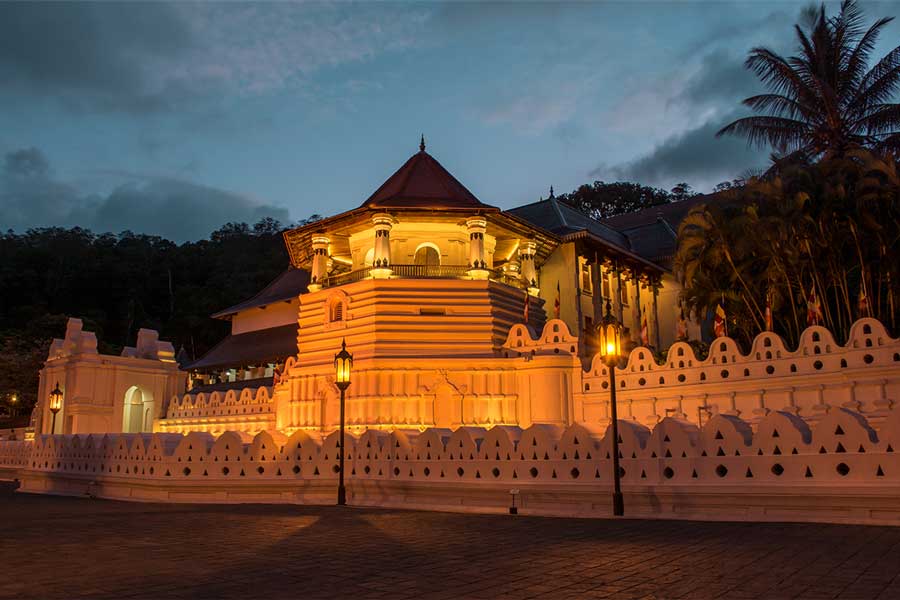Best Places to Visit in Kandy
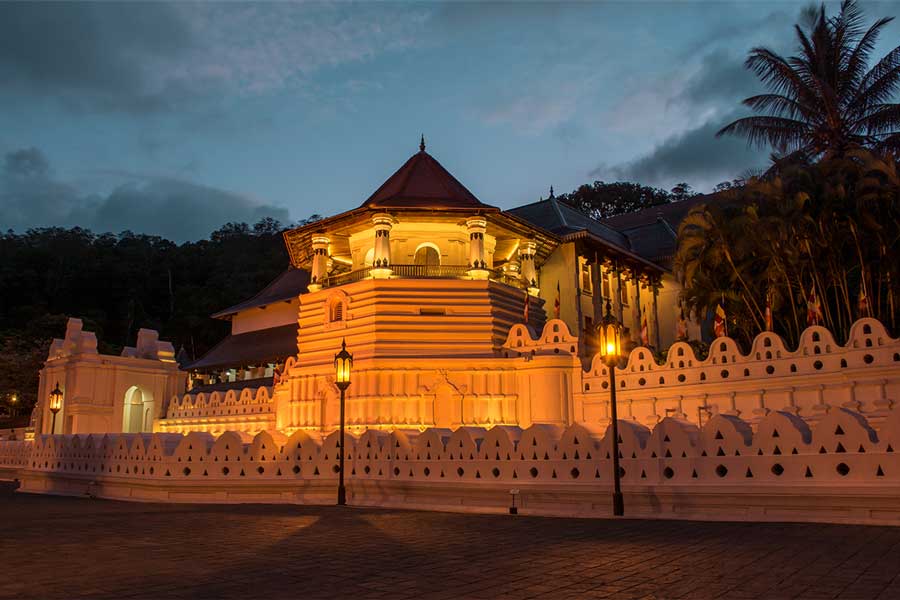
Kandy is famous for its historical and cultural heritage. A city resting on a plateau in the Central Province of Sri Lanka, Kandy has many historical sites that would enchant visitors. A region with a cool breeze gently cascading down the surrounding hills and whispering past trees, the area is filled with a sense of tranquility and reverence. No doubt this atmosphere is brought about by the fact that the Temple of the Tooth (The Dalada Maligawa) features prominently in the region.
The golden canopy that shelters the most hallowed place in the temple is where the Sacred Tooth Relic of the Buddha is preserved. During the conducting of the pooja (prayers) the relic is exposed to the public and the atmosphere inside the temple is so soothing and impressive that one feels the tranquility that envelopes all devotees. The tooth relic is not visible to the devotees as it is encompassed in a stupa (a dagoba shaped like an apparatus).
The Kandy Esala Perahera is a procession that is conducted on a grand scale in the month of July and August. This Perahera winds its way through the streets of Kandy with explicit pomp and pageantry. A notable feature is that the Sacred Tooth Relic is carried in a brightly decorated casket secure upon an elephant, as he walks with much pride and serenity, aware of the task that has been entrusted to him. The Perahera is filled with many events such as stilt walkers, Kandyan dancers (a skill that will keep you in awe), whip dances, and fire dances.
The Kandy Lake is a picturesque sight as it flows serenely as if aware of the presence of the Temple of the Tooth Relic. This lake was formerly a stretch of paddy fields and was transformed into a lake by King Sri Vikrama Rajasinha in 1807. The paddy fields had a pond set in the middle which was called Kiri-Mudu (Sea of Milk). Legends and folklore say that there was a small island in the center that was used by the King’s harem for bathing and this island was connected to the palace through a secret tunnel.
The beauty of Kandy rests in the fact that it is nestled in the midst of a range of mountains lusciously planted with tea. The rows of well laid out tea bushes create a different atmosphere to the area. The cool climate in Kandy gives an aura of freshness to the area.
Make it to Kandy the next time you are in Sri Lanka and feel the difference.
Are you planning to Visit Kandy?
Check out the places we recommend you to visit on your trip to Kandy
Temple of the Tooth
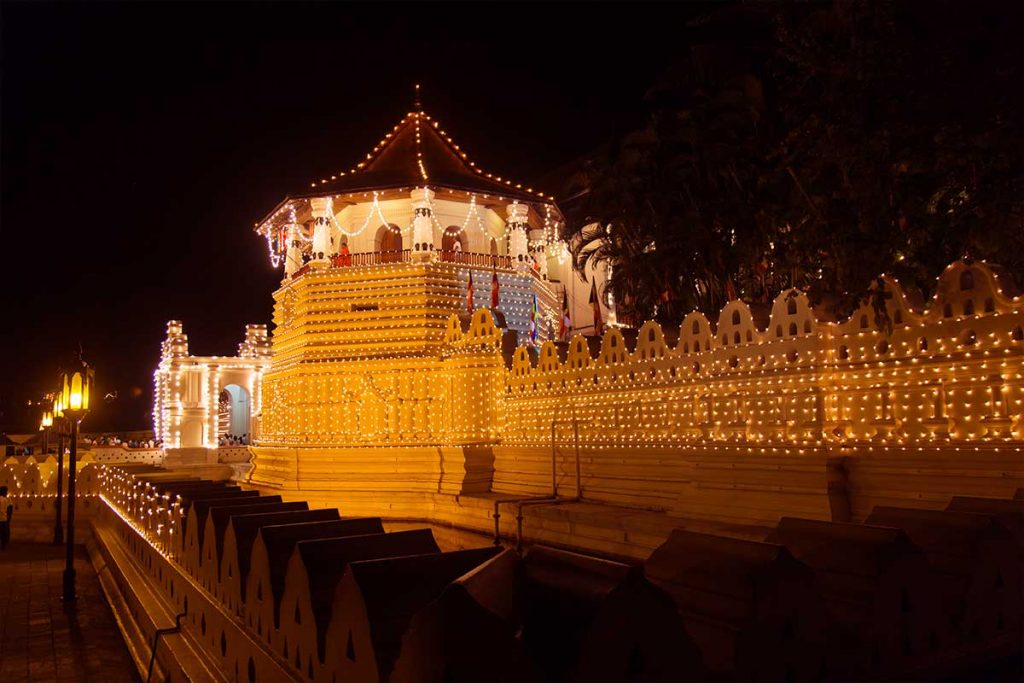
The Temple of the Tooth Relic or the Sri Dalada Maligawa is situated in the heart of Kandy town, overlooking the ‘Kiri Muda’ (Sea of Milk), as the Kandy Lake was once known. The Temple is significant as it houses the tooth relic of the Lord Buddha, which is preserved in the inner chambers of the temple. There is very illustrious history to this sacred temple where it is said that the tooth relic was once preserved in Kalinga and was smuggled into the country by Princess Hemamali and Prince Dantha on the instructions of her father King Guhasiva.
The architecture which adorns the Temple is a sight to behold and visitors are in awe each time they view the beautiful painting and sculptures that are present even today. There is a wall made out of brick that runs alongside the moat and Bogambara Lake, which is called the water waves wall. There are holes that have been built in the walls which provide space to light coconut oil lamps, which is a part of worship in temples throughout Sri Lanka. The entrance gate to the Temple is named the Mahawahalkada and the most eye-catching of this is the moonstone or Sandakada Pahana, which has been carved beautifully at the foot of the Mahawahalkada steps. This moonstone has been carved in Kandyan architectural style.
The golden canopy covers the main shrine and there is a golden fence that enfolds it. The tooth relic is protected within seven gold caskets which adorns expensive gemstones. The caskets are shaped like a stupa. The casket which is used during the Kandy Esela Perahera and placed upon a majestic elephant is also displayed within this chamber. The Esela Perahera is conducted an easy year and is an annual event that is looked forward to by many tourists and people around Sri Lanka. The Sacred Tooth Relic is carried in a casket that is placed upon a majestic elephant and the Perahera or procession winds its way through Kandy with whip dancers, stilt walkers, fire-dancers who show off their skills to all those who throng either side of the route the Perahera takes.
The Royal Palace, the Audience Hall, Mahamaluwa are a part of this hallowed building.
Temple of the Tooth Location on the Map
Kandy Lake
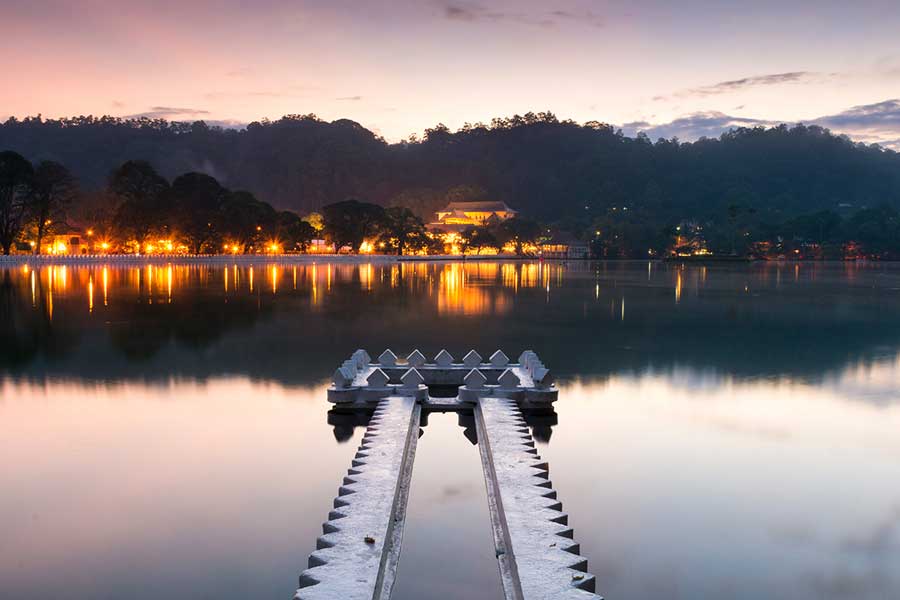
Kandy Lake is also known as the Bogambara River and the Kiri Muda which is also called the Sea of Milk. It is an artificial lake which is situated in the heart of the City of Kandy and was constructed by King Sri Vikrama Rajasinha in 1807. The Lake lies next to the Temple of the Tooth Relic. The area where this lake is stated was once a paddy field called Tigolwela. And the reason for it to be called the Kiri Mudu was that there was a pond in the center of this lake which was used by the King’s Harem for bathing purposes and the story tells us that there was a secret tunnel that led to the palace from this pond.
It is said that Deveda Moolacharya was the architect of the Kandy Lake and the King first built a dam that ran across the paddy fields. This dam commenced from the Pattiruppuwa or Octagon and the steps that lead to the lake are still visible. This is by the Mahamaluwa or Esplanade. The Kandy lake is surrounded by a wall which is called the Walakulu Bamma or the Clouds Wall. This was constructed to enhance the beauty of the lake. However, Sri Vikrama Rajasinha could not complete the construction of this Wall as by that time the city was captured by the British and the King was forced to relinquish the Kingdom. This Walakulu Bamma is still an unfinished structure. One would see the triangular-shaped holes that are embedded in the wall; these are used to light oil lamps during the Esela Perahera and other festivals.
There are Nuga trees, palm and fruit trees that adorn the borders of the Kandy Lake accompanied by Sal trees and Mara trees. These trees no doubt are around 74 years old. Along with the trees, what adds to the splendor of this beautiful lake are the species of birds which include the white egret crane, the wood stork, pelican and also the Indian cormorant.
Kandy Lake Location on the Map
Peradeniya Botanical Garden
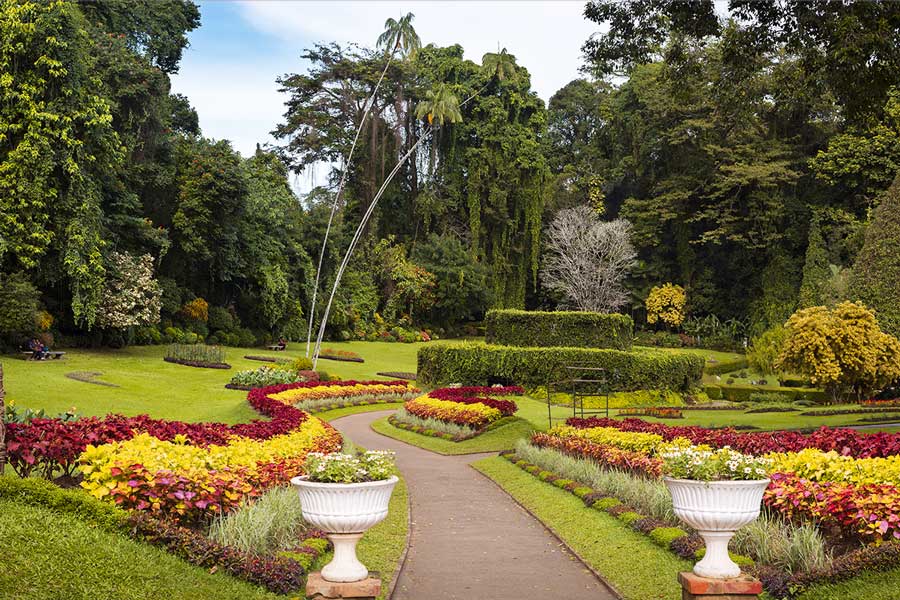
The Peradeniya Botanical Garden was founded in 1821 with the aim of introducing coffee trees and accompanying tropical plantations that authorities thought would enhance the economy. The gardens have remained a horticultural arena of activities throughout its existence. In the late 1870s Botanist George H.K. Thwaites was involved in starting the country’s flourishing tea industry. He went a step further and introduced the Brazilian rubber tree which later became one of Sri Lanka’s main three export produce. Overtime the botanical produce has seen a huge change for the better.
The Peradeniya Botanical Garden has a stunning range of fauna and flora and was once a haven for royalty in the Kandyan Kingdom. And today, with its sprawling 67 hectares of land, it is open to the public, so that they could enjoy its natural beauty. The gardens are inundated with a beautifully landscaped area that is adorned with different varieties of orchids, an avenue that is neatly set with royal palms swaying slowly to the rhythm of the cool breeze, the astonishing aptly named canon ball fruit tree that adorns the green lawn. Another very popular tree is the giant Javan Fig Tree that sits on the green lawn with its gigantic central trunk and umbrella-style canopy of branches.
The gardens are inundated with bats and thousands of monkeys who will quietly snack a fruit out of your hands. But this is their habitat and they are a part of this palatial sprawling Garden.
The botanical gardens are a walking distance from the Kandy Railway station and buses ply along with the route stop by the gardens. The gardens are a tourist attraction and so transportation is in abundance. Another attraction at the gardens is that it can be used as a place to have a picnic and is considered by both locals and tourists as a wonderful place to rest and unwind. When we mention a picnic it means you could bring your food and layout a checked table cloth and indulge in the beauty of nature as you tuck into the delicacies. You could call it a green picnic.
The gardens have seen many a ruler from Kings to the British, but over the years it has not lost its beauty and a fact that it is one of the most sought after tourist attractions in the world.
Peradeniya Botanical Garden Location on the Map
Bahirawakanda Vihara Buddha Statue
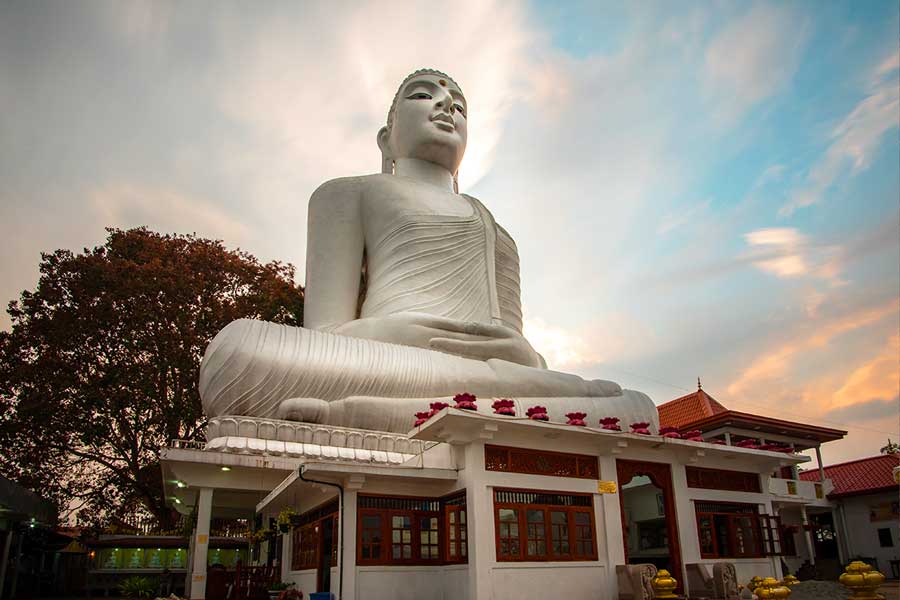
The Giant Buddha Statue of Bahirawakanda known as Bahirawakanda Vihara Buddha Statue, rises from a hill which adjoins the hallowed city of Kandy.
There are many legends that encompass the hill of Bahirawakanda, which also means “Gnome Mountain”. There are many legends that surround this hill and are more superstitions rather than realities.
The very first legend is that the ancient temple was erected in dedication to a primitive God called Bahirawa, which was entrenched there during the reign of the Nayakkar Kings. It is said that during those days in India the fixed methods of worship for Lord Bahirawa involved animal sacrifices and human sacrifices were never a part of worship. But over time the practices at this temple changed and the priests who ran this temple insisted that human sacrifices should be a part of the worship and insisted that 100 virgin women be sacrificed at a time. The people of that era were native and not educated enough to understand the adverse situation of this part of the worship and so they handed over a number of girls as sacrifices.
However sacrificing of virgin girls ended when the fiance of the Chief of the Royal Mahouts Dunuwille Gajanayaka Nilame, was taken for sacrifice and this mad the Nilame so angry that he employed all his power within the palace and his bravery to have the girl released. This caused such a lot of chaos in the vicinity that ended the sacrificing of virgin girls’ ritual. This also ended the superstitions engulfed in the peoples’ minds and the temple was uninhabited for some time.
The Bahirawakanda Vihara Buddha Statue is situated alongside the Sacred Temple of the Tooth Relic. The Statue of Lord Buddha has been beautifully sculptured in a seated Nirvana pose and is visible to the entire city of Kandy. The Statue is 88 feet tall and definitely is one of the biggest Buddha statues in Sri Lanka. From the top of the hill, you can witness the beauty of Kandy and the range of mountains with a cool breeze blowing in all directions.
The Bahirawakanda Vihara Buddha Statue is a popular place of worship. Devotees are expected to follow the rules of piousness by removing their hats and shoes before entering this sacred ground. A staircase runs at the rear side of the Buddha statue which visitors can climb to get a better view of the sprawling landscape. It is recommended that the best time to visit Bahirawa Kandy is at night when the whole statue shines brilliantly with lights fixed all around and the landscape projects a dotted area of colorful lights that twinkle in the stillness of the night.
Bahirawakanda Vihara Buddha Statue Location on the Map
Embekka Devalaya
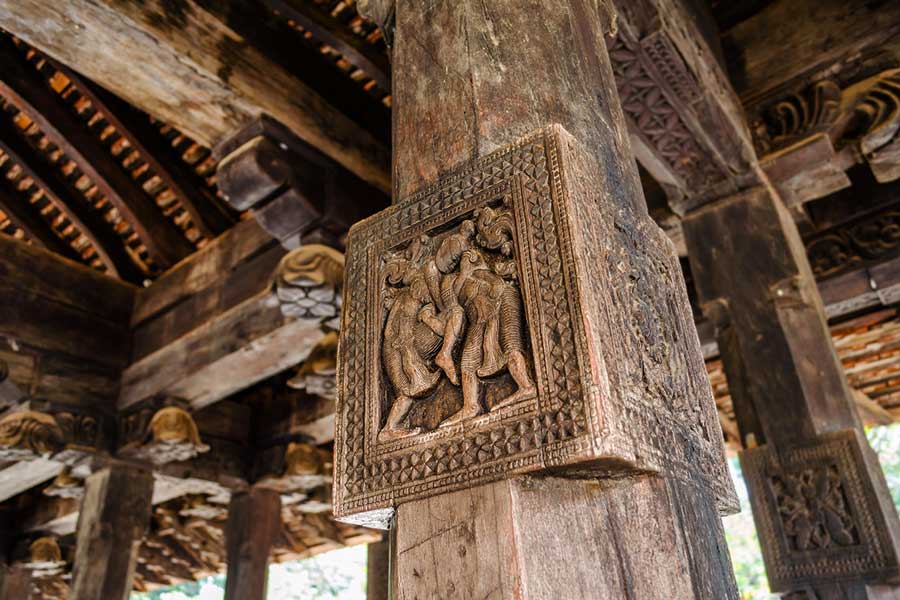
King Wickramabahu III was the initiator of the Embekka Devalaya (AD 1357 – 1374). This Devalaya is situated in Kandy in the Central Province of Sri Lanka and is dedicated to Lord Kataragama and Dedvatha Bandara.
The carvings and woodwork of the devalaya are picturesque and is said to be from an abandoned “Royal Audience Hall” at Gampola. The most obvious examples of Sinhala art can be seen from the carvings which are on the wooden pillars of the Drummers’ Hall. The roof is a significant feature that meets the eye of any visitor first hand. This is because the rafters are at an angle from above pointing towards any incoming visitor and are entwined together securely by a “Madol Kurupawa.” This is a sought of a giant pin, which is not available in any location other than in this sacred place. Hence the Embekka Devalaya is famous for its wood carvings.
The Devalaya is divided into two areas, one is the Digge (dancing hall) and the other the Hewsi Hall (Drummers Hall). The most fascinating part of this Devalaya is the wood carvings and the carved beams, rafters and doorways. Among the most fascinating of carvings are the Hansa Puttuwa (interlinked swans) a carving that is even used in the present era in houses and is thought to bring good luck. Further, the double-headed eagles, the entwined rope designs and the mother breastfeeding her baby are among the most beautiful of carvings in the Devalaya.
A unique feature of the Devalaya is the beautiful carving of an elephant bull and also an elephant with his trunk elongated which has something mystical about it. The mystery behind this carving is that if you cover it with your palm, the figure on the carving resembles a bull, but in actual terms, it is the figure of an elephant with its truck elongated. And when you cover your palm over the elephant still the figure that emerges is that of a bull.
No doubt Sri Lanka has a rich history and heritage. The history, culture and heritage of this beautiful island are no doubt one of the best in the world.
Embekka Devalaya Location on the Map
Gadaladeniya Temple
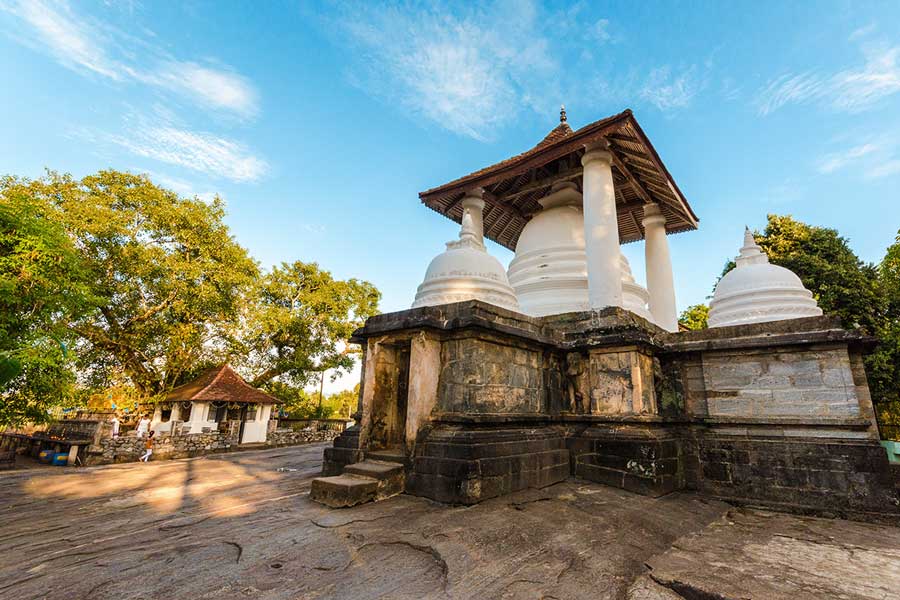
The Temple of Gadaladeniya (Gadaladeniya Temple) is also known as Saddharmatilaka Vihara or Dharma Kirthi Viharaya and is an ancient viharaya located in Pilimithalawa, Kandy. If one looks at the history of this temple is goes back to the 14th century. A look at historical data relates to the fact that this temple was built in 1344, under its founder King Buwanekabahu IV. It is significant to note that the architecture of this ancient temple was designed in line with Hindu artistic styles by Ganesvarachari, who was a South Indian architect. One could see the details of the temple’s construction which is carved upon a rock on the outcrop. The temple had been the residence of several scholarly monks such as Sangharaha Dharmakirthi II and Vimalakirti.
The temple has the main shrine as well as a secondary shrine. The uniqueness of this temple is that the central part of the temple is built exclusively of sculptured granite. The main entrance to the shrine is adorned by an intricately designed Makara Thorana (Dragon’s Arch). This Makara Thorana is decorated with images of Brahma, Sakra, Santusita, Saman, Santhusthika, Natha and Maitreya. Within this hallowed shrine room exists an 8.0 ft statue of the Lord Buddha in a sitting position. According to the doctrines of the Buddhist Philosophy, this posture of reflection is related to the Lord Buddha’s first enlightenment. This statue is fringed by four standing Buddha statues.
Alongside the main shrine room on the northern part of it is a devale which is dedicated to Lord Vishnu who is a Hindu God.
The secondary shrine is located in the center of the temple premises. This shrine was built after the main shrine by King Parakramabahu V. This shrine consists of a central stupa which is just about 40 ft high and constructed on a square platform. The whole stupa is covered by a four-sided roof which are supported by four pillars.
Gadaladeniya Temple Location on the Map
Lankatilaka Temple
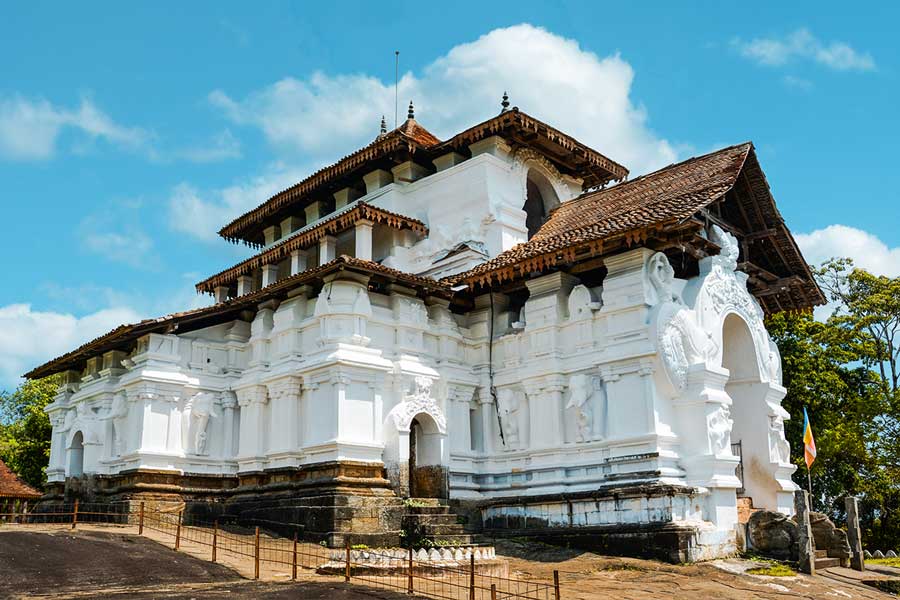
The Lankatilaka Temple is an ancient temple which is located in Udunuwara, Kandy. Its location is on the Daulagala road and is approximately 4 km from the Pilimatalawa junction and also close to the Gadaladeniya Temple. The Temple is considered to be the most brilliant architectural building constructed during the Gampola era. The temple building has been constructed on a natural rock which is called the Panhalgala Rock. The entire viharaya (temple) is positioned on the rock surface.
The temple has a history that dates back to the 14th century. Historical reports depict that the temple was built by King Bhuvanekabahu IV, who was King from 1341 to 1351 AD. The King entrusted the construction of the temple to his Chief Minister Senalankadhikara, who was responsible for the successful completion of the temple.
From the buildings, the image house stands out with its outstanding architectural features which are embroidered with traditional Sinhala sculpture works. According to details recorded in the Lankthilleke Copper Plaque, the image house was built as a 4-storied manor, standing 80 ft. tall, but today only 3 stories are visible. Kandyan era paintings adorn the walls of the image house. There are rock-carved inscriptions in the premises of the temple in the Sinhala and Tamil Sections, which proclaim about the initiators and facilities gifted to this temple. There are also 5 Devales (Kovils) where 5 Gods are worshiped in these Devales; the Gods are Upulvan, Ganapathi, Saman, Vibhishana, Kumara Bandara. God Kumara Bandara is supposed to be the God who looks over the Lankatilleke Temple.
There are two approaches to reach the Temple, but the easiest is from the Sanghawasa, which is located towards the bottom of the rock and the Western End of the temple leads to Lord Vishnu’s Temple of the chief viharaya.
The Lankatilaka Temple still stands as an icon from the era of history of Sri Lanka.
Lankatilaka Temple Location on the Map
Hanthana Mountain Range
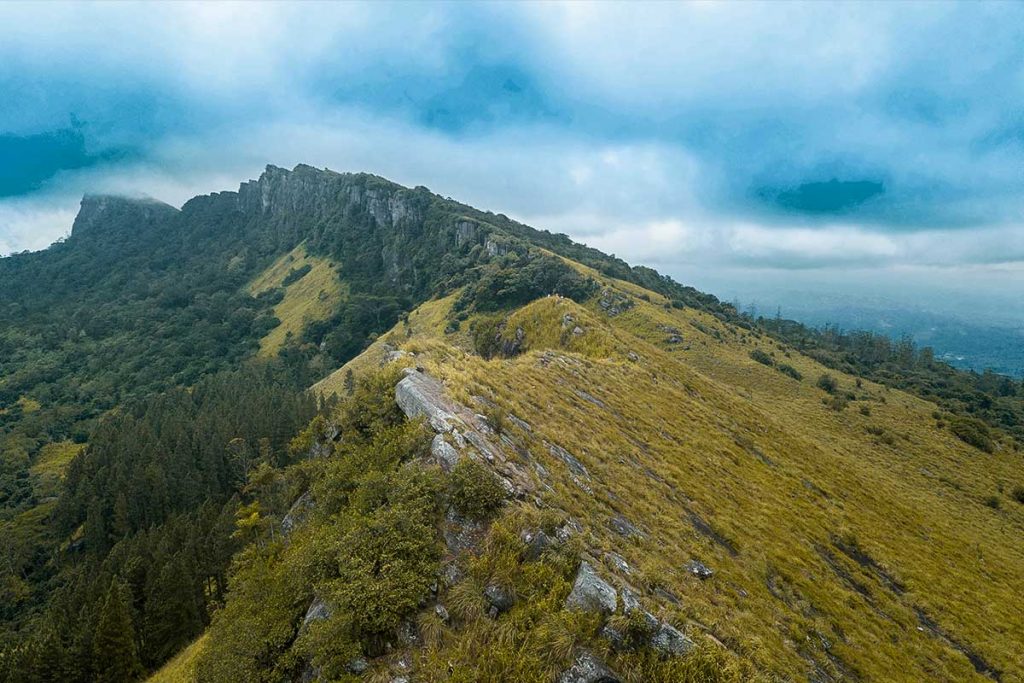
The Hanthana Mountain Range is situated in the Central Province of Sri Lanka and consists of seven peaks. The range of mountains was proclaimed an environmental protected area in February 2010. The range goes up to 3800 ft. Out of the seven peaks, the highest in the Uura Kanda. The range poses a beautiful and famous destination for mountain bikers in Sri Lanka. It is a haven for hikers as well and bird watchers, as it brings you so close to nature with the latter.
When you hike up the mountain range you could get a beautiful view of Kandy which lies ahead of you. Moreover, the mountain range is famous for its many varieties of birds and is ideal for bird watching. At times raptors and a handful of endemic birds can be spotted. The trial for hikers encompasses many ascents and descents. Hikers will experience hiking among tea estates of the Upper Lance, prior to getting to the Hanthana Mountain Range. Once you have traversed the mountain range, a footpath leads you to Kandy. This footpath is the ideal location for bird watching and viewing the picturesque landscapes below.
The Hanthana mountain range was chosen as destinations for radio transmission towers due to its height above sea level. The Tea Industry Museum is another attraction on the Mountain Range. This museum will give take you back to the origins of how tea leaves were manufactured. Apart from the processes, a visitor could take a look at the ancient machinery that was used to process tea and photographs that adorn the walls of this Museum will take the visitor on a ride into history.
Apart from the above you need to be attired in suitable clothing which will protect you from the sun, rain and wind. Along with these suitable clothing insect repellent is a must.
Sri Lanka is famous for its picturesque beauty in the Hill Country and the Hanthana Mountain Range occupies a special place in the history of the country.
Hanthana Mountain Range Location on the Map
Udawatta Kele Sanctuary
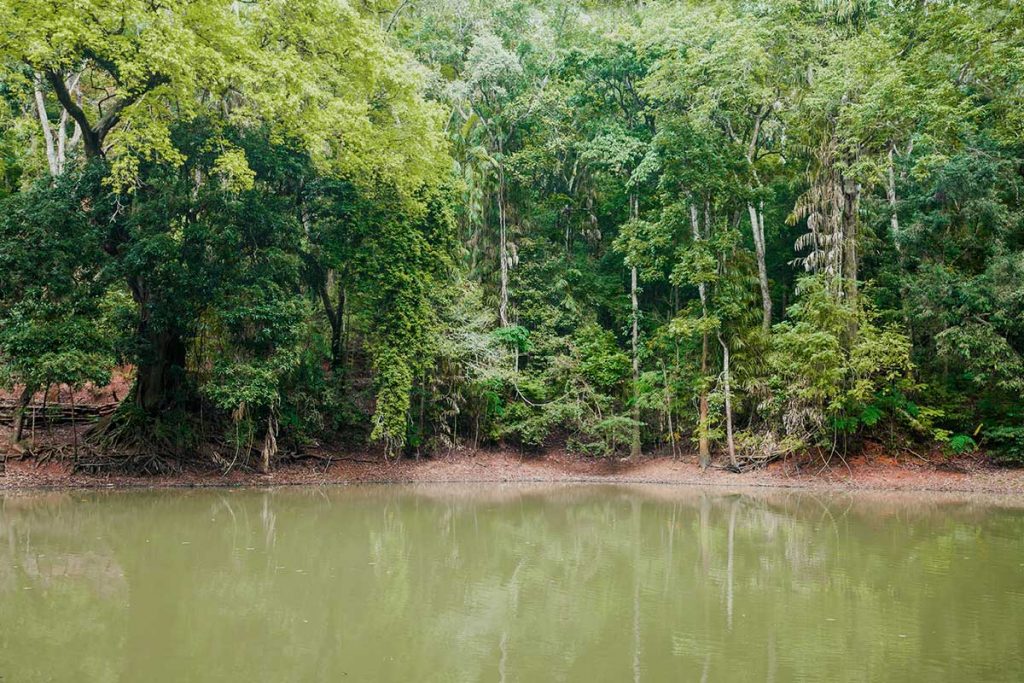
Udawattakele Forest Reserve (Udawattekelle Sanctuary) is also known as the Royal Forest Park in Kandy and rests behind the Temple of the Tooth Relic or the Dalada Maligawa. The forest consists of a stretch of 257 acres and is today considered to be an important bio reserve for the extensively populated City of Kandy. Many years ago, actually it would be right to say centuries ago, the surrounding areas of Kandy were rain forests and it was only during the reign of King Parakramabahu (1302 – 1326 AD) that human beings settled down in these areas.
When King Wickramabahu became King, Kandy was called “Senkadagala”. The name came to be due to the fact that a Brahmin called Senkada made his abode in a cave at Udawattekelle during this period. The Udawattakele Forest Reserve had many names to it during the reign of Kings and one of them was “Uda Wasala Wewa” which in English means “Upper Palace Garden”. This area was a frequently visited area by royals and was out of bounds for the ordinary people of the area. The Kandyan Kingdom’s downfall came in 1815 and ever since then, this forest lost its charm as woodcutters began felling trees, etc.
The condition of this beautiful forest began deteriorating with time due to humans devastating it by felling trees and living off the wood that was sold. The government declared the area as a Forest Reserve in 1856 and in 1938 it was turned into a Sanctuary. The Kandy Lake which is a popular icon in the City of Kandy is literally supported with water from the catchments within the Sanctuary.
The places of interest within Udawattekelle Sanctuary are the water pond, highest peak “Kodimale,” the Senkada Cave and the Garrison cemetery. The forest also contains several Buddhist temples and hermitages. The visitors’ entrance is to the western side of the sanctuary and could take about 20 minutes to walk from the Temple of the Tooth Relic to this entrance.
There are many species of plants growing in the forest some of them are orchids, indigenous lianas, creepers and vines. The sanctuary has an emergent layer, a canopy and an understory. The latter is less in its presence due to the dense conditions of the sanctuary which sunlight is at a minimum.
However, in recent years the sanctuary has faced many threats, one of which is the encroachment of squatters and grabbing of land by owners in surrounding lands. Although this threat has been minimized, there is always a possibility that it would come up again.
Udawatta Kele Sanctuary Location on the Map
Other important tourist places that you can visit along with Kandy
Nelligala International Buddhist Center
Kandy View Point
Kandy Garrison Cemetery
Ceylon Tea Museum
Kandy War Cemetery
World Buddhist Museum
Alagalla Mountain Range
Ranawana Viharaya
The Church of St Paul
Degaldoruwa Temple
National Museum Kandy

